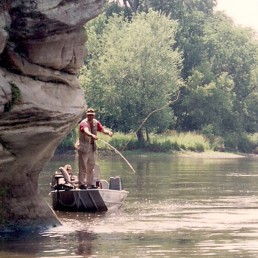Catfish and Fly Fishing
SHARE THIS POST
Silently drifting through the air, the line snakes its way across the water. Dawn is just breaking through the mists as the streamer drops delicately on the surface and sinks below. This is what I love most about fly fishing.
The line tightens as a forked-tail fish mouths the streamer and moves off to deeper water. Catfish like to eat their prize in the safety of deep water.
Using a streamer to catch catfish? Streamers are for fly fishing. Catfish do not bite a fly. Or do they?
Today’s fly anglers have expanded their list of prey. Catfish are the most recent to join the list of the hardcore fly angler, and the most fun. Mr. Whiskers is available in almost any body of water in mid-America.
River catfish prefer a drop-off area where a riffle meets a pool. In the evening, they move up to the shallow eddies and flats where they feed through the cooler nighttime temperatures. During these feeding periods, they are most vulnerable.
If you’re interested in catching catfish on a fly rod, begin with a 9-foot, fairly stiff rod (6- to 8-weight) with a weight-forward line to match. For bulkier flies, a bass taper weight-forward line is good. A good tackle shop can help with the choice.
If using more than one line, store the spares on extra spools so that you can change lines in response to lure selection and varying water conditions.
Are you enjoying this post?
You can be among the first to get the latest info on where to go, what to use and how to use it!
For smaller to middlin’ cats, about 5-pound test monofilament works well in a length of three to four feet for the tippet. If larger cats are present, upsize to around 10- to 12-pound test instead. If seeing the line is not a problem, then a colored mono line is okay. A float indicator or a small ultra-light float can help identify a light bite.
For choice of fly, lean toward anything that imitates a crayfish, leech, or nightcrawler. Channel catfish tend to be bottom feeders. To match the hatch, match what is swimming or crawling on the bottom.
Fishing time is early morning up until about an hour after sunup. This bite does not last a long time. Do it for a while and then you can move on to other types of fishing.
You can fly fish for catfish on just about any lake, river, or pond. If wading, do so with great care as holes in the bottom can cause serious problems.
Catfish are a muscle with whiskers on one end and a forked tail on the other. On the light tackle of a fly rod and line, it is a formidable challenge. And a fun way to begin the day.
If you enjoy catfishing, you’ll find suggestions for locations and techniques in every issue of MidWest Outdoors, available by subscribing on our website.
MWO
SHARE THIS POST
You may also like...
Nothing found.
Did you enjoy this post?
You can be among the first to get the latest info on where to go, what to use and how to use it!
Don Gasaway
Don Gasaway is a veteran freelance outdoor writer from Marion, Ill. He may also be found at: https://www.facebook.com/DonGasawayWriter and facebook.com/Wandering Angler. Comments are welcome
